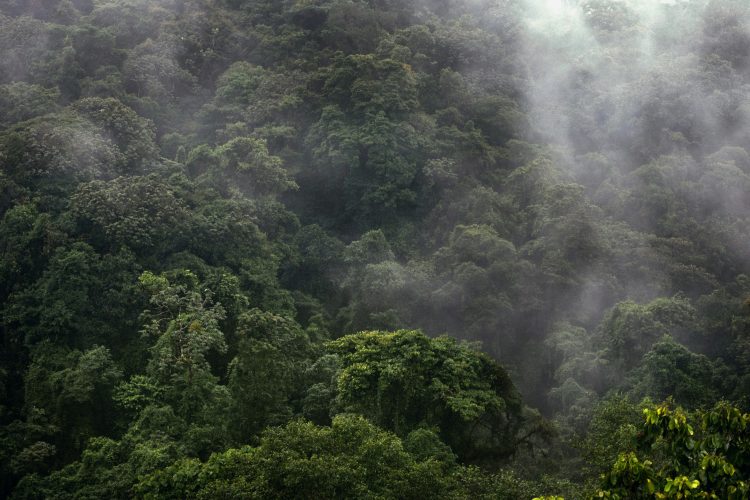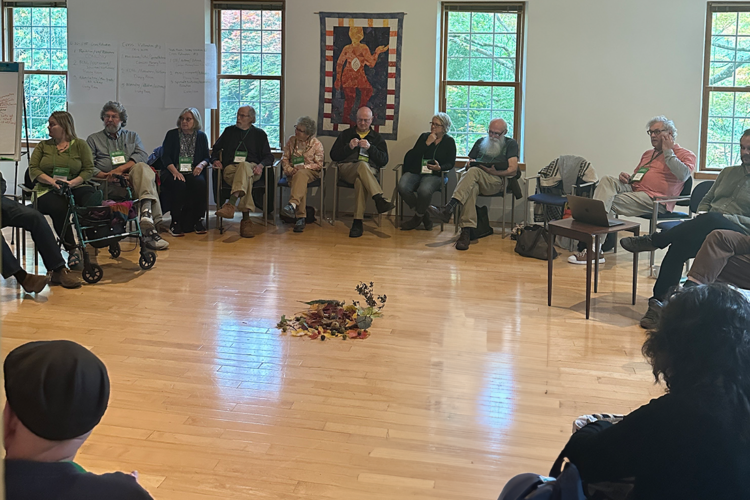The Heaven Under our Feet

THOUGH, AS A SPECIES, we may have journeyed through immense reaches of time and space, we remain close to our origins, to Eden, and to wilderness. They are within us and right beneath our feet.
Scripture tells us God formed us “of dust from the ground” (Genesis 2:7); created us “from dust, then from a drop of seed” (Koran, Surah XXII.5). Our progenitor, Adam, is adama—soil, or clay. We Homo sapiens are capable of wisdom, perhaps, but are most assuredly Homo (from humus, of soil or earth).
Astrophysicists inform us that the very elements of our being are stardust, exploded matter of ancient stars. Agronomists note that all life receives its nourishment from rocks ground slowly down to dust by ice and water and spread by the winds of time.
No less than ourselves, the soil that supports us is alive. A handful of good soil contains more living creatures than the grand total of human beings who have ever lived on the earth. We have names for and understand the functions of perhaps 5 percent of these mostly invisible creatures—no matter whether they live in a Costa Rican cloud forest or an Ohio backyard.
The most numerous of these creatures are bacteria. Take a pinch of pristine forest soil: you hold about a billion of them, of perhaps one million distinct species, communicating and evolving so swiftly that they outwit our antibiotic strategies. They invented recycling, photosynthesis, and genetic engineering. As Stephen Jay Gould admits, they “rule the earth.”
Your same pinch of soil may also contain thousands of wispy root hairs and several miles of mycorrhizae, networks of microscopic fungus threads interdependent with the roots of plants, drawing polysaccharide energy from them and in turn enabling them to absorb phosphorus, nitrogen, other nutrients, and water. All terrestrial ecosystems depend on this underground “web that holds it all together” (Gary Snyder). Without mycorrhizae, which extend a plant’s root system by 1000 percent or more, most plants could not have emerged from the water, to thrive on “dry land.” Either by themselves or combined with algae as lichens, fungi are indispensable to the creation of soil and evolution of life. We are equally dependent on the lowly roundworm, which endlessly ingests, turns over, and fertilizes virtually every crumb of soil on earth. Tiny nematode worms account for four out of every five animals on earth. In a square meter of soil, there may be as many as 10 million of them. In that same space, we might find a billion protozoa, hundreds of thousands of springtails and mites, and thousands of arthropods—insects with jointed legs—some of them so tiny that 20 or 30 might dance within the period at the end of this sentence.
In soil ecology, the process culminates in humus, the relatively stable end-product of countless ingestions, decompositions, and excretions of organic plant and animal material by fungi, bacteria, protozoa, earthworms, nematodes, and arthropods. Wendell Berry marvels over the formation of organic humus as “the chief work of the world.” Often characterized as the life-force of the soil, humus stores and slowly releases carbon and nutrients, holds up to 90 percent of its own weight of water, circulates oxygen, suppresses disease, resists erosion, and enables formation of good soil structure, ideal habitat for the very creatures who cooperated to form it, thus creating the conditions for their own survival—and ours. With a modicum of science and a little imagination, we can view our own bodies as habitat, designed and organized over countless millennia as shelter, reservoirs, and food sources, by the microbes that colonize us and, in return, keep us alive. We are inheritors and beneficiaries—along with soil, sunflowers, beetles, and dolphins—of 3.5 billion years of microbial exploration and discovery.
The disheartening part of this long, miraculous story is that in the last few centuries we have been busily destroying the very body of the soil and our own bodies with our chemical fertilizers, our pesticides, our deep tilling, our monocultures, our failure to return plant residues to the soil, and the anthropogenic warming of the planet—a warming which breaks down humus and releases carbon dioxide in a prime example of positive feedback. Not very long ago in our brief history as a species, we lost the wisdom of our ancestors—still preserved among some indigenous peoples—the cultural memory of how to live in harmony with the ground of our being.
Fortunately, the lost intelligence we seek to recover, the secret to restoration of the lost garden, is still alive and breathing. Accessible within minutes, it persists in small patches of earth, harboring an astonishing remnant of wilderness and its self-regulating intelligence, enough to serve as basis for regeneration.
In our own bodies, remnants of the most ancient life forms are virtually immortal: bacteria, mitochondria, and other tiny organisms, subsumed by our cells and our selves. Each of us is an ecosystem, a community of life, akin to that handful of soil with its billions of living creatures. Like the soil, our very bodies carry the memory and recapitulation of everything that ever was.
Every species and every community of species is a unique form of cosmic memory, held, repaired, reproduced, and continually transformed by genes and enzymes inherited from the most ancient forms of life and shared out among all creatures—microbes, grasses, elephants, rattlesnakes.
Our body remembers; it knows what to do when we do not. The soil has its own intelligence; it remembers how to recover when we abuse and degrade it. Indigenous communities retain ancient wisdom, enough to provide for recovering from centuries of repression and for living more fully according to their “original instructions.” Communities of scientists—ethnobotanists, ecologists, biochemists, even quantum physicists—are helping us remember and regenerate what we have forgotten: the ancient wisdom and practice of living in harmony with the earth.
Can we be silent long enough to hear and respond to voices that call to us from deep within our own bodies? Can we attune our ears to the harmonies of the land, drowned out as they often are by dissonances and cacophony of our techno-civilization?
Let us hope that if we keep our ears to the ground, we may yet hear what Lynn Margulis calls “earth’s sentient symphony” and Lewis Thomas “the music of this sphere.” By harmonizing with the music of the soil and by cooperating with its intelligence, we may yet become wiser and restore our bodies, and our souls. Eden, the unfallen world, endures and is continually renewed in the very dust of the native soil we repeatedly seek to shake from our restless feet. Stop. Take a stand wherever you are.
Practice mindfulness, and do no harm: preserve as much as possible of what remains. Then, seek to restore. Begin with your yard and garden. Continue with the grounds of the school, the meeting, the church, a garden in the park, a vacant lot, an abandoned field, your neighborhood.
Grow as much as possible of your own food. Support the local farmers and indigenous peoples who seek to recover—and improve—ancestral wisdom and practice. Learn the flowers and grasses that evolved in this place where you live. Bring them back, and the creatures that co-evolved with them will be fostered and revived—yourself as well. The spirit and the memory of earth will be manifest. In this faith, in this work of hearts and hands, the world is “all alive” and “every particle of dust breathes forth its joy” (William Blake, Europe, 1794).
FURTHER READING:
- David R. Montgomery, Growing a Revolution: Bringing Our Soil Back to Life. W. W. Norton, 2017.
- James B. Nardi, Life in the Soil: A Guide for Naturalists and Gardeners. Univ. of Chicago Press, 2007.
- Kristin Ohlson, The Soil Will Save Us. Rodale, 2014.
Tom Small, Kalamazoo Friends Meeting, is a member of the QEW Publications Committee and co-author of Using Native Plants to Restore Community.

